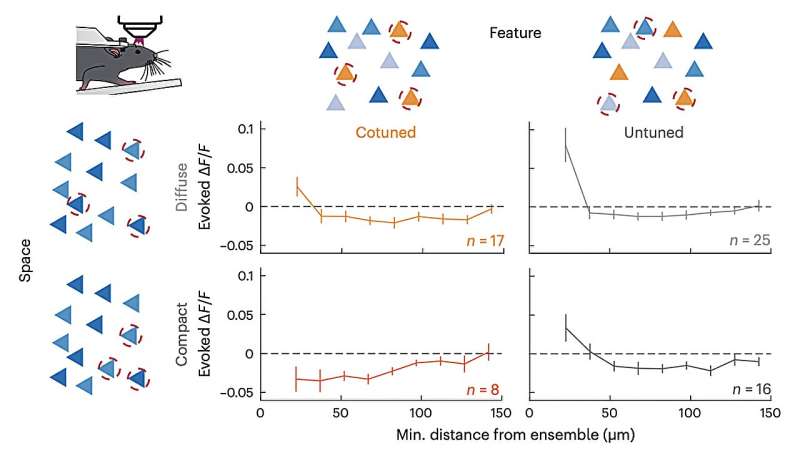January 25, 2024 feature
This article has been reviewed according to Science X's editorial process and policies. Editors have highlighted the following attributes while ensuring the content's credibility:
fact-checked
peer-reviewed publication
trusted source
proofread
The logic underlying recurrent activity in the primary visual cortex

In mammals, the perception of visual stimuli is supported by the coordinated activity of thousands of neurons in different brain regions. The images perceived by the eyes are represented in the brain, passing various steps through which representations are increasingly refined.
A brain region that plays a key part in the processing and neural representation of visual stimuli is the so-called primary visual cortex or V1. Past studies suggest that the recurrent excitation of neurons in this brain region amplifies responses when visual signals are weak, while the recurrent inhibition of neurons suppresses responses when signals are strong,
While experimental findings suggest that recurrent excitation and suppression play a key role in the detection and discrimination of objects or subjects in visual images, the cortical patterns driving these processes are still poorly understood. A better understanding of these patterns could help to shed further light on the complex mechanisms underpinning human vision.
Researchers at University of California, Berkeley (UC Berkeley) and other institutes in the United States recently carried out a study investigating recurrent activity in the primary visual cortex. Their findings, published in Nature Neuroscience, suggest that the preferences of cortical ensembles impact V1 local recurrent activity following a straightforward logic.
"Recurrent cortical activity sculpts visual perception by refining, amplifying or suppressing visual input," Ian Antón Oldenburg, William D. Hendricks and colleagues wrote in their paper. "However, the rules that govern the influence of recurrent activity remain enigmatic. We used ensemble-specific two-photon optogenetics in the mouse visual cortex to isolate the impact of recurrent activity from external visual input."
Oldenburg, Hendricks and their colleagues carried out a series of experiments on adult mice. Firstly, they used high-resolution two-photon (2P) holographic optogenetic techniques to recreate precise patterns of neuronal activity in the mouse brain. They then measured the impact of these patterns across the primary visual cortex, using 2P calcium imaging with cellular resolution.
"We found that the spatial arrangement and the visual feature preference of the stimulated ensemble and the neighboring neurons jointly determine the net effect of recurrent activity," the researchers wrote in their paper. "Photoactivation of these ensembles drives suppression in all cells beyond 30 µm but uniformly drives activation in closer similarly tuned cells. In no similarly tuned cells, compact, co-tuned ensembles drive net suppression, while diffuse, co-tuned ensembles drive activation."
After conducting their experiments, the researchers used computational techniques to model their observations. This allowed them to make better sense of how the groups of neurons they stimulated influenced recurrent activity in the V1.
"Computational modeling suggests that highly local recurrent excitatory connectivity and selective convergence onto inhibitory neurons explain these effects," the researchers explained in their paper. "Our findings reveal a straightforward logic in which space and feature preference of cortical ensembles determine their impact on local recurrent activity."
The recent work by Oldenburg, Hendricks and their collaborators gathers valuable new insight about the neural processes that could drive the amplification and suppression of activity in the mammalian primary visual cortex. Overall, the team's findings suggest that recurrent activity patterns observed in the V1 are modulated via neural processes unfolding following a specific logic, which ultimately allows the brain to derive detailed representation of complex visual stimuli.
In the future, these results could pave the way for new studies investigating the complex neural underpinnings of visual perception.
More information: Ian Antón Oldenburg et al, The logic of recurrent circuits in the primary visual cortex, Nature Neuroscience (2024). DOI: 10.1038/s41593-023-01510-5.
© 2024 Science X Network





















